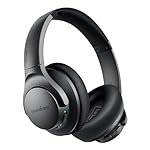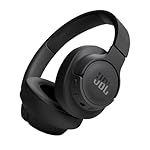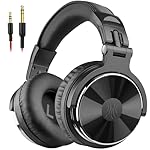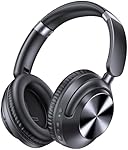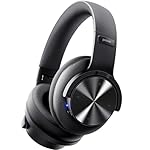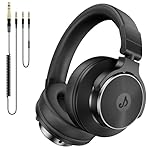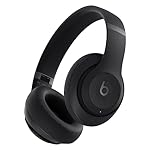Over-ear headphones are designed for immersive listening, delivering full-bodied sound and high comfort. With large earcups that surround the ears, they reduce fatigue and deliver immersive sound better than most designs. Whether you’re commuting, producing audio, or relaxing at home, over-ears offer a versatile and often superior experience.
Unique Features of Over-Ear Headphones
What sets over-ear headphones apart is their physical design and audio capabilities. They offer spacious earcups that sit around the ear instead of on it, helping to improve both passive isolation and comfort. Padding is usually generous, with materials like memory foam and leatherette or velour, providing a plush fit even during long sessions.
Another defining factor is their acoustic design. Open-back models allow air and sound to flow through the back of the earcups, creating a natural and wide soundstage. These are favored for critical listening but leak sound and let in external noise. Closed-back models seal the ear completely, which blocks more ambient noise and enhances bass response. These are ideal for commuting or environments where isolation is important.
Driver size and type are also notable. Over-ears can house large drivers, including planar magnetic options known for exceptional clarity and bass accuracy. Many high-end models benefit from external headphone amplifiers to perform their best, particularly those with higher impedance.
Wireless options often include features like active noise cancellation (ANC), ambient modes, and multipoint Bluetooth connectivity. Battery life is generally longer in over-ears compared to smaller wireless headphones, making them great for extended use.
Key Specs & Features Explained
Driver Type
The driver is the component that converts electrical signals into sound. Most over-ear headphones use dynamic drivers, which rely on a moving coil and diaphragm to generate sound. They’re efficient, affordable, and deliver strong bass, but can vary in precision depending on tuning and materials.
Planar magnetic drivers use a flat diaphragm suspended between magnets to produce sound with very low distortion and excellent transient response—ideal for critical listening and audiophile use, though they usually require more power and are heavier.
For casual and versatile use, dynamic drivers with 40–50 mm diaphragms strike a balance between efficiency and sound depth. For studio or hi-fi setups, planar models often outperform dynamic ones in clarity and imaging.
Driver Size
Driver size is measured in millimeters and generally influences bass response and overall loudness. Larger drivers (45–50 mm) move more air, which can produce fuller low frequencies and greater dynamic range. However, size alone doesn’t determine sound quality—tuning, materials, and enclosure design matter equally.
- 40 mm drivers: Compact, balanced sound with moderate bass.
- 45–50 mm drivers: More impactful bass and higher output potential.
- 50 mm+: Common in audiophile or studio models, offering extended low-end depth but may require more power.
Frequency Response
Frequency response indicates the range of sounds the headphones can reproduce, typically shown in hertz (Hz). The standard range for human hearing is 20 Hz–20 kHz, but premium headphones may extend from 10 Hz up to 40 kHz. Broader ranges can improve clarity and detail, but only when the response is smooth and well-tuned.
Look for a flat response within ±3 dB across the audible spectrum for accurate sound reproduction. Headphones tuned to emphasize bass may show a rise around 60–120 Hz, while bright models often lift the 2–5 kHz range.
Harman Curve
The Harman Curve is a scientifically derived frequency response target representing the average listener’s preferred tuning. Headphones that closely follow this curve deliver a natural balance between bass, mids, and treble, often perceived as “neutral but engaging.” Many top consumer models—especially from Sony, Bose, and Sennheiser—tune their headphones toward this profile. If you prefer a balanced, all-genre listening experience, choose models advertised as Harman-tuned or that show measurements aligning with this curve.
Sound Signature
Sound signature defines how a headphone emphasizes different frequency ranges. Common signatures include:
- Neutral: Balanced and accurate; ideal for mixing or analytical listening.
- V-shaped: Boosted bass and treble with recessed mids; popular for pop and rock.
- Warm: Emphasized low mids and bass for a smoother tone.
- Bright: Enhanced treble that brings out detail but can become fatiguing.
For general listening, a mildly V-shaped or Harman-like signature suits most users. Studio or reference headphones should aim for neutral response.
Impedance & Sensitivity

These two specs determine compatibility with your playback device.
- Impedance (Ω): Resistance to electrical current. Low impedance (< 32 Ω) headphones are designed for smartphones and laptops. High-impedance models (80–300 Ω) need dedicated amplification to reach optimal performance.
- Sensitivity (dB/mW): Indicates how loud headphones will get at a given power level. Values above 100 dB/mW are considered efficient.
And here’s what to look for:
- For portable use: Impedance ≤ 32 Ω, Sensitivity ≥ 100 dB/mW.
For studio or high-end listening: Impedance 80–250 Ω, with a quality headphone amp.
Noise Cancellation & Isolation
Active Noise Cancellation (ANC) uses microphones and phase-inverted signals to cancel ambient noise. Premium models can reduce 20–35 dB of external sound, especially in low frequencies.
Passive isolation depends on earcup seal and padding materials. Over-ear models with dense foam and snug clamping often block 10–15 dB passively.
If you travel or work in noisy environments, look for ANC performance above 25 dB, adjustable modes (e.g., transparency), and effective passive sealing around the ears.
Wireless Features & Codecs
Bluetooth performance depends heavily on supported codecs, which determine audio quality and latency:
- SBC: Standard codec, lower quality, higher latency.
- AAC: Optimized for Apple devices, good balance of quality and stability.
- aptX / aptX HD: Better for Android; delivers near-lossless sound at lower latency.
- LDAC: High-resolution codec (up to 990 kbps) for audiophile-level wireless playback.
If you use Apple devices, make sure that the device has AAC support, and if you use Android, look for aptX Adaptive or LDAC.
Bluetooth 5.2 or higher ensures stable connectivity and better battery efficiency. Also check for multipoint pairing, low-latency mode, and touch or voice assistant controls.
Battery Life
Battery performance varies widely depending on ANC usage and codec. Typical modern over-ear models offer 30–50 hours with ANC off and 20–30 hours with ANC on.
Fast charging is now standard, providing 3–5 hours of playback from 10–15 minutes of charge. If you travel often, target 40+ hours total battery life and USB-C fast charging capability.
Comfort & Build
Comfort is driven by materials, ergonomics, and weight distribution. Look for:
- Padding: Memory foam or gel-infused pads reduce pressure over long sessions.
- Weight: Under 350 g is generally comfortable for extended use.
- Clamping force: Around 0.6–1.0 N per side is ideal—secure without excessive pressure.
- Materials: Metal or reinforced plastic headbands add durability; protein leather or velour ear pads enhance comfort and breathability.
For studio or daily wear, choose models under 350 g, with replaceable pads and adjustable headbands.
Nice-to-Have Features
Though not essential, the following features add value and flexibility:
- Foldability: Earcups that swivel or collapse into a travel case make storage easier.
- Replaceable Parts: Swappable earpads or detachable cables extend the product’s life and allow for upgrades.
- Custom EQ: Software-based equalizers let users fine-tune the sound to match personal preferences.
- Premium Codecs: Advanced wireless codecs provide better fidelity, especially when streaming high-quality audio.
- Multipoint Bluetooth: Staying connected to multiple devices at once streamlines switching between work and play.
- Touch Controls or Sensors: Smart features like auto-pause or gesture controls make daily use more intuitive.
- Style & Materials: While not performance-related, visual appeal and luxury materials can elevate the ownership experience.
- Water Resistance: Some models offer limited resistance to moisture, useful in unpredictable weather.
Best Over-Ear Headphone Brands
The over-ear headphone market includes a mix of long-established audio specialists and newer tech-driven brands. Each has its own design priorities, sound profile, and pricing approach. Knowing what a brand tends to excel at helps narrow your options before you start comparing individual models.
Sony
Sony is widely recognized for combining advanced noise cancellation, strong wireless performance, and comfort. Its tuning typically leans toward a consumer-friendly balance with a slight emphasis on bass and warmth.
- Pros: Industry-leading ANC, long battery life (often 30–50 hours), reliable Bluetooth connectivity, consistent build quality.
- Cons: Sound can be too bass-heavy for purists; replacement parts and ear pads can be expensive.
Bose
Bose focuses on ease of use and all-day comfort. Their headphones emphasize smooth, relaxed sound and excellent active noise cancellation—especially effective for travel and office use.
- Pros: Exceptional ANC, very lightweight builds, intuitive controls, good microphone quality for calls.
- Cons: Sound lacks the dynamic range or detail that audiophiles prefer; limited codec support (typically SBC/AAC only).
Sennheiser
Sennheiser is one of the most respected names in high-fidelity audio, known for accurate, natural sound reproduction and solid engineering. Their lineup covers everything from entry-level wireless models to studio-grade wired headphones.
- Pros: Balanced, detailed sound; wide frequency response; premium materials and comfort; replaceable parts on many models.
- Cons: High-end models can require amplification; wireless versions sometimes trail behind Sony and Bose in ANC performance.
Audio-Technica
Audio-Technica specializes in professional and enthusiast-grade wired headphones, with a reputation for clarity and accurate tonal balance. Their products often appeal to musicians, DJs, and studio users.
- Pros: Excellent sound accuracy, durable design, and competitive pricing; broad range from budget to studio gear.
- Cons: Limited active noise cancellation options; wireless offerings are less refined than larger consumer brands.
Beyerdynamic
A German brand known for precision and build quality, Beyerdynamic caters heavily to professionals and serious listeners. Their over-ear headphones are often made with replaceable components for longevity.
- Pros: Detailed, spacious soundstage; excellent comfort with velour pads; modular design for easy maintenance.
- Cons: Many models have high impedance (≥250 Ω) and require an amp; not ideal for portable use.
Bang & Olufsen (B&O)
B&O blends high-end design with warm, spacious sound. Their products are aimed at style-conscious listeners who value aesthetics as much as performance.
- Pros: Premium materials, refined sound signature, luxury build quality.
- Cons: Expensive for the audio performance; shorter battery life compared to Sony or Bose; proprietary parts can be hard to replace.
Shure
Originally known for microphones and in-ear monitors, Shure also produces over-ear headphones built for accuracy and monitoring.
- Pros: Neutral tuning, solid construction, and foldable professional designs; good passive isolation.
- Cons: Fewer lifestyle features (no ANC or app integration in many models); utilitarian aesthetics.
Apple (and Beats by Apple)
Apple’s over-ear lineup, including Beats, prioritizes seamless ecosystem integration and user experience. Beats models tend toward bass-heavy sound, while Apple’s offerings focus on spatial audio and convenience.
- Pros: Excellent integration with iOS devices, quick pairing, stable wireless connection, and reliable ANC.
- Cons: Premium pricing; limited customization outside the Apple ecosystem; tuning may not suit neutral listeners.







